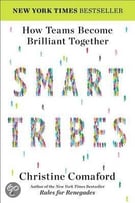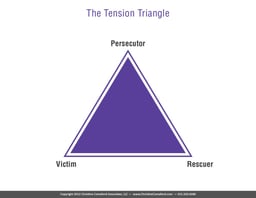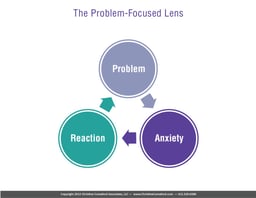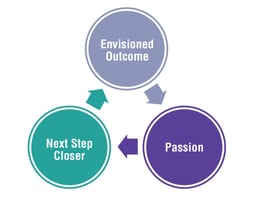In your organization, which do you focus on, Problems or Outcomes?
UCLA research recently found that 50–70% of an organization’s collective emotional state is determined by its leaders. This means that if we’re problem-focused, our people likely are too. It’s essential to learn the tools to shift your organization and yourself from problem-focused thinking to outcome-focused.
In chapter 8 of Christine Comaford’s Smart Tribes, in addition to providing the idea on the Energy Allocation Chart, Comaford shares how a huge energy drainer that slurps away sustainability is triggered emotional reaction from our Critter State, instead of a chosen response from our Smart State.
First let’s take a look at the difference between Comaford’s definitions for Smart State and Critter State.
Smart State: Comaford describes this as where we have full access to creativity, problem solving, innovation, higher consciousness, and emotional engagement. Why smart”? Because the proactive, innovative part of the brain is consistently in the driver’s seat. In this state, we’re able to access all of our internal resources and respond from choice instead of reacting impulsively from fear. We’re able to envision an exciting future and feel drawn and compelled by it, as we eagerly anticipate the exciting rewards it holds.
Comaford goes on to examine the idea of why Smart Tribe and specifically, Why “tribe”? There’s a reason tribe has become the new buzzword; the latest neuroscience research shows that our very sense of survival depends upon a sense of belonging. When that sense of belonging isn’t there, even in the workplace, fear kicks in. And our primal survival “fight/flight/freeze” brain takes the driver’s seat and kicks our innovative brain to the curb. A tribe is all about collaboration, connection, shared goals, and emotional engagement.
Contrast this with:
Critter State: Where we put our teams into fight/flight/freeze, without access to our greatest resources. Comaford offers,” leaders we often unintentionally send our teams into the part of their brains where optimal performance is tremendously compromised.
- This can happen when a company Is navigating rapid growth where internal priorities are frequently shifting and the team is challenged to quickly adapt and stretch Has unclear directives Has inconsistent accountability structures and communication rhythms
- Has a culture where the blind spots and challenging behaviors of the leaders are not being addressed
- Has unresolved conflict and/or low alignment among the leadership of the company Is changing its business model or executing a complete company turnaround
- All of the above are common in growth scenarios.
As leaders all of us need to learn techniques to avoid sending our teams into their Critter State and to help them shift into—and stay in—their Smart State.
When you and your team focus on Problems you are in Critter State. It’s a huge energy drainer! We emotionally react in our Critter State, instead of a choosing to respond from our Smart State. The critter brain sends us into fight/flight/freeze until we know how to manage it.
Comaford suggests that a fascinating exercise is to note how often you react in ways that are automatic and unconscious versus responding in ways that are based on full conscious choice.
Comaford shares the research in Smart Tribes on the three Roles we play. (Check it out Smart Tribes if you want more verification on this)
Victim, Rescuer, Persecutor
There are three basic default roles that people lean toward: Victim, Rescuer, Persecutor. These three roles are interdependent (there must be a Persecutor for there to be a Victim for the Rescuer to save), and together they make up what we refer to as the Tension Triangle. See the picture for a view of The Tension Triangle.
You’ve probably witnessed this already. I’ve been in relationships with a Victim many times in my life because my default role is to be a rescuer. The victim needs the rescuer and vice versa. Yet if we can get into a place where we use the Rescuer’s Smart State we achieve positive outcomes. The strength of a Victim is they are outcome focused. When we help the victim into their Smart State they discontinue acting like a victim. They focus on the outcomes they want. They become creative, solve problems, innovate, have higher consciousness, and emotional engagement.
Here is how Comaford describes it. When we’re in the Tension Triangle, we’re problem-focused and tend to see things as shown here. Being problem-focused sucks our  energy, leads us to look for ways to allocate blame, and feels constricting, like a jacket that’s too tight. When we’re problem-focused, we are in our Critter State, in fight/flight/freeze. Stay there too long and you’ll slide into apathy. And that takes a lot more energy to shift out of!
energy, leads us to look for ways to allocate blame, and feels constricting, like a jacket that’s too tight. When we’re problem-focused, we are in our Critter State, in fight/flight/freeze. Stay there too long and you’ll slide into apathy. And that takes a lot more energy to shift out of!
The Problem-Focused Lens
Comaford also offers another drawback to being problem-focused. It can interfere with the way we see Maps—ours and others’—and it can lead to self-sabotage, which we generally do (unconsciously) in two ways: We get stuck in our Map and miss the opportunity to add new helpful resources to it to help ourselves grow. We stay in our Map while trying to influence another—but if we don’t step into their Map, we will likely miss powerfully influencing outcomes. (I’ll discuss maps Comaford discusses here in another blog. Trust the idea here and we’ll explore this further.)
With the tools Comaford provides, we can switch to being outcome-focused, which looks like this.
The Outcome-Focused Lens
Being outcome-focused feels very different. It’s empowering and energizing, and fills us with confidence. It firmly places you in your Smart State, where possibility, choice, innovation, love, and higher consciousness are abundant.
Not sure whether you’re problem- or outcome-focused?
Think about the questions you ask:
Problem-oriented questions
- What’s wrong?
- Why is this happening?
Outcome-oriented questions
- What do we want?
- How will we create it?
What Role Do You Play? We all have a default role, one we learned early in life. This role has shaped our lives, and it is often what prevents us from fostering sustainability in ourselves and in our teams. Our role may keep us (or others) in our Critter State, or cause unhealthy dependency. This is how I determined I am a rescuer. What are you?
We’ll look at what we can do to get the people we manage out of their Critter state in our next blog.






.jpeg?width=150&height=135&name=Hand%20with%20marker%20writing%20the%20question%20Whats%20Next_%20(1).jpeg)

